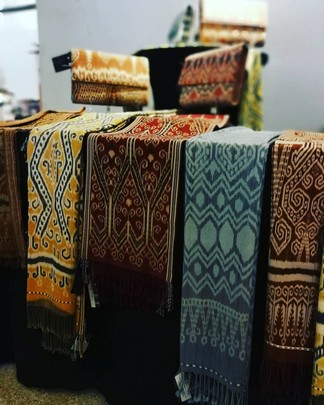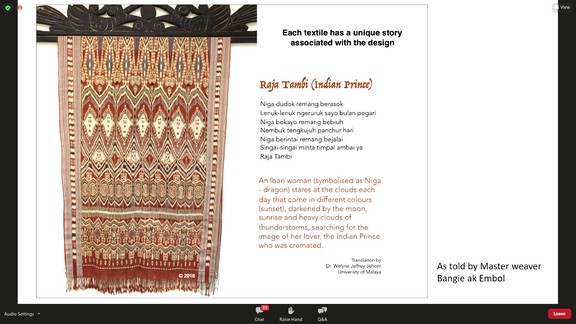For centuries, stories have been woven into textiles. For instance, different styles of block printing from different regions of India describe their diverse communities and environments, while textiles weaved by the Q’ero people of Peru chronicle their rich cultural history.
In Sarawak, the designs found on the pua kumbu depict tales deriving from traditional beliefs and rituals as well as folklores of the Iban.
Furthermore, according to anthropologist Dr. Welyne Jeffrey Jehom from Universiti Malaya, each of these textiles, which utilises the tie-dye (ikat in Malay; kebat in Iban) method, has its own ubiquitous identity through the stories reflected in the intricate colours and patterns produced by the weaver.

Some designs are even considered sacred and are only shared within the family, given that among the functions of pua kumbu is to serve as a protective blanket during healing and rituals.
“Each design carries a name, a rhyme or a story, and different colour tones signify each pua kumbu as a distinctive piece.
“So it is acknowledged that the folktale and also the storyline is very important in the creation of the pua kumbu,” she says.
The Challenge in Interpretation

In her presentation ‘Traditional Textiles and Costumes’ as part of Spotlight on Sarawak – a series of talks organised by the Heritage of Malaysia Trust between April and July 2022 – Dr. Welyne showcases a few pua kumbu pieces from her years of field work.
Designs of this “dream weaving”, as the art is known for, are usually based on motifs found in nature, including birds, snakes, frogs, flowers and fruits. Other, more significant symbols in accordance to Iban myths and legends tend to be humans and spirits.
The eventual piece in general contains numerous abstract and hidden meaning and words, and can be fully interpreted and told through motifs by the weaver.

“However, it is very difficult to translate word by word each of the Iban word in the poem or the name of the pua kumbu because it doesn’t make sense,” Dr. Welyne notes.
She adds that the pua kumbu needs “to be understood in context”; although their work is inspired by their dreams of Iban cosmology and the relationship between the human and spirit worlds, different weavers have their own reading of what they witnessed.
This is compounded by the present reality that pua kumbu is under threat, with the meaning of the pua kumbu designs lost either due to the passing of owners and creators, or the reluctance to pass them down to the younger generation, given the complication in understanding them.

“That’s why many of the old pua kumbu have ended up in the museum or with private collectors. The underlying belief behind the animistic designs has also been lost,” Dr. Welyne laments.
As such, there have been research and documentation on the traditional textile locally and globally to ensure its longevity.
For Dr. Welyne, with its close connection with Iban oral literature, she believes that pua kumbu serves as a tool and platform for weavers to narrate their story – what they see, hear, imagine and dream about.
“So when contextualising and legitimising pua kumbu, the factors to consider include the purpose for which it was woven, its date and historical context, the life story of the weaver herself, as well as being aware of the rich repertoire of references to Iban legend, religion and oral history that suggest that the role of the pua kumbu has traditionally played within the Iban society, which is evident in the myth that form the basis of their social and religious lives,” she surmises.
What is Pua Kumbu
A warp-patterned, ceremonial blanket, cloth or textile woven by Iban women on a back-strap loom. However, the term pua kumbu tends to be used to refer to the art of pua weaving, or any item that features the Iban kebat designs and motifs.

In the traditional life of the Iban, pua kumbu is used in ceremonies related to birth, marriage, healing and funeral, as well as in farming rituals. In the past, it was utilised to receive heads from those returning from a victorious war expedition.
Today, the textile serves as a symbol of the Iban’s identity and heritage, and an exceptional material culture of Sarawak. Sources:
Sarawak Museum Department
Jeffrey Jehom, Welyne. (2017). Memories of textiles narratives: Iban weavers restoring pua kumbu knowledge in Sarawak.






[…] https://www.rakansarawak.com/v3/2022/08/01/the-storytelling-intricacies-of-pua-kumbu/ […]